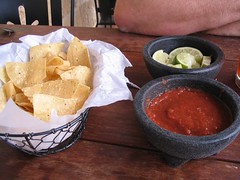The cuisine that would come to be called Tex-Mex actually originated with Tejanos (Texans of Hispanic descent) as a hybrid of Spanish and native Mexican foods when Texas was part of New Spain and later Mexico.
From the South Texas region between San Antonio and the Rio Grande Valley, this cuisine has had little variation and from earliest times has always been influenced by the cooking in the neighboring northern states of Mexico.
Tex-Mex cuisine is characterized by its heavy use of melted cheese, meat (particularly beef), beans, and spices, in addition to Mexican-style tortillas. Texas-style chili con carne, chili con queso, chili gravy, and fajitas are all Tex-Mex inventions.[citation needed]
Serving tortilla chips and a hot sauce or salsa as an appetizer is common in Tex-Mex restaurants.[citation needed] Moreover, Tex-Mex has imported flavors from other spicy cuisines, such as the use of cumin (common in Indian food but used in only a few authentic Mexican recipes).
Then what is Mexican cooking all about?
When conquistadores arrived in the Aztec capital Tenochtitlan (now Mexico City), they found that the people's diet consisted largely of corn-based dishes with chilies and herbs, usually complemented with beans and tomatoes. The conquistadores eventually combined their imported diet of rice, beef, pork, chicken, wine, garlic and onions with the native indigenous foods of pre-Columbian Mexico, including chocolate, maize, tomato, vanilla, avocado, guava, papaya, pineapple, jicama, chile pepper, beans, squash, sweet potato, peanut, fish and turkey.
Most of today's Mexican food is based on ancient traditions, such as the Aztecs and Maya, combined with culinary trends introduced by Spanish colonists.
Quesadillas, for example, are a flour or corn tortilla with cheese (often a Mexican-style soft farmer's cheese such as Queso Fresco or Queso Oaxaca ), beef, chicken, pork, and so on. The indigenous part of this and many other traditional foods is the chili pepper. Foods like these tend to be very colorful because of the rich variety of vegetables (among them are the chili peppers, green peppers, chilies, broccoli, cauliflower, and radishes) and meats in Mexican food.
Subscribe to:
Post Comments (Atom)


No comments:
Post a Comment